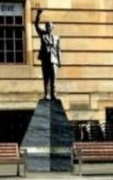About the statue | More information | Videos
 The statue: A celebration and a legacy
The statue: A celebration and a legacy
 This statue of Nelson Mandela in Glasgow celebrates the history of Scotland’s connection to the struggle against apartheid through the Anti-Apartheid Movement and is a legacy for future generations to learn about the key part Scotland played in taking action for human rights and challenging racism, and on taking action for a better world. Read more here.
This statue of Nelson Mandela in Glasgow celebrates the history of Scotland’s connection to the struggle against apartheid through the Anti-Apartheid Movement and is a legacy for future generations to learn about the key part Scotland played in taking action for human rights and challenging racism, and on taking action for a better world. Read more here.
On 4 August 1981, Glasgow awarded Nelson Mandela the Freedom of the City while he was still in prison – the first city in the world to do so. In Scotland, Aberdeen in 1984 and Midlothian and Dundee in 1985 also granted him freedoms. In 1986, Glasgow renamed St George’s Place – the home of the apartheid South African Consulate – as Nelson Mandela Place.
Nelson Mandela was welcomed by over 15,000 people in George Square when he visited Glasgow in 1993 to receive the Freedom of Glasgow and eight other cities and boroughs in person.
Known and loved around the world for his commitment to peace, negotiation and reconciliation, Nelson Rolihlahla Mandela was an anti-apartheid revolutionary and political leader. After 27 years in prison, he became South Africa’s first democratically elected president (1994-1999) when the African National Congress (ANC) came to power.
On 9 October 1963, he and 10 others were convicted of sabotage at the Rivonia Trial and he remained in prison until his release in 1990 and the subsequent overthrowing of apartheid.
At his trial he famously said: “I have fought against white domination, and I have fought against black domination. I have cherished the ideal of a democratic and free society in which all persons live together in harmony and with equal opportunities. It is an ideal which I hope to live for and to achieve. But if needs be, it is an ideal for which I am prepared to die.”
 Resources and more information
Resources and more information
![]() What was apartheid?
What was apartheid?
 Apartheid (literally “apart-hood” in Afrikaans) was a system of racial segregation enforced by the ruling National Party in South Africa. Between 1960 and 1983, 3.5 million black Africans were removed from their homes and forced into segregated neighbourhoods as a result of apartheid legislation, in some of the largest mass evictions in modern history. Many South Africans died in the struggle – see more information on the Sharpeville Massacre and the Soweto Uprising.
Apartheid (literally “apart-hood” in Afrikaans) was a system of racial segregation enforced by the ruling National Party in South Africa. Between 1960 and 1983, 3.5 million black Africans were removed from their homes and forced into segregated neighbourhoods as a result of apartheid legislation, in some of the largest mass evictions in modern history. Many South Africans died in the struggle – see more information on the Sharpeville Massacre and the Soweto Uprising.
![]() ‘When Mandela Danced in the Square’
‘When Mandela Danced in the Square’
In collaboration with the Nelson Mandela Scottish Memoriaql Foundation, thisd is a West of Scotland Development Education Centre (WOSDEC) resource to help second and third level learners to:-
- understand the context of apartheid South Africa, the life of Nelson Mandela and the connections to the Scottish anti-apartheid movement
- draw links to examples of modern day injustice
- develop their speech-making skills to raise awareness of real world issues
![]() Timeline of Nelson Mandela’s Life from the Nelson Mandela Foundation
Timeline of Nelson Mandela’s Life from the Nelson Mandela Foundation
His life, his imprisonment, the defeat of apartheid, and becoming President of South Africa.
![]() Timeline of the Scottish Anti-Aparthied Movement
Timeline of the Scottish Anti-Aparthied Movement
A brief history.
![]() The Apartheid Museum
The Apartheid Museum
The Apartheid Museum, the first of its kind, illustrates the rise and fall of apartheid.
![]() Robben Island Museum
Robben Island Museum
The infamous prison where Nelson Mandela spent 18 of his 27 years, along with over 3,000 political prisoners during their fight to end Apartheid.
![]() ‘The Glasgow Mandela Story’ – book by Brian Filling
‘The Glasgow Mandela Story’ – book by Brian Filling
![]() Scottish Anti-Apatheid Movement Archive – Glasgow Caledonian University
Scottish Anti-Apatheid Movement Archive – Glasgow Caledonian University
![]() Mandela-Tambo lecture series. – Link needed.
Mandela-Tambo lecture series. – Link needed.
![]() The Lilliesleaf Trust UK – Anti-Apartheid Legacy: Centre of Memory and Learning (opening in 2023)
The Lilliesleaf Trust UK – Anti-Apartheid Legacy: Centre of Memory and Learning (opening in 2023)
 Videos
Videos

![]() Film footage of Nelson Mandela’s visit to Glasgow
Film footage of Nelson Mandela’s visit to Glasgow
![]() Prisoner of Apartheid – Freeman of Glasgow: 40th anniversary of Mandela being awarded Freedom of the City
Prisoner of Apartheid – Freeman of Glasgow: 40th anniversary of Mandela being awarded Freedom of the City
![]() Celebrating Nelson Mandela Day 2021
Celebrating Nelson Mandela Day 2021
